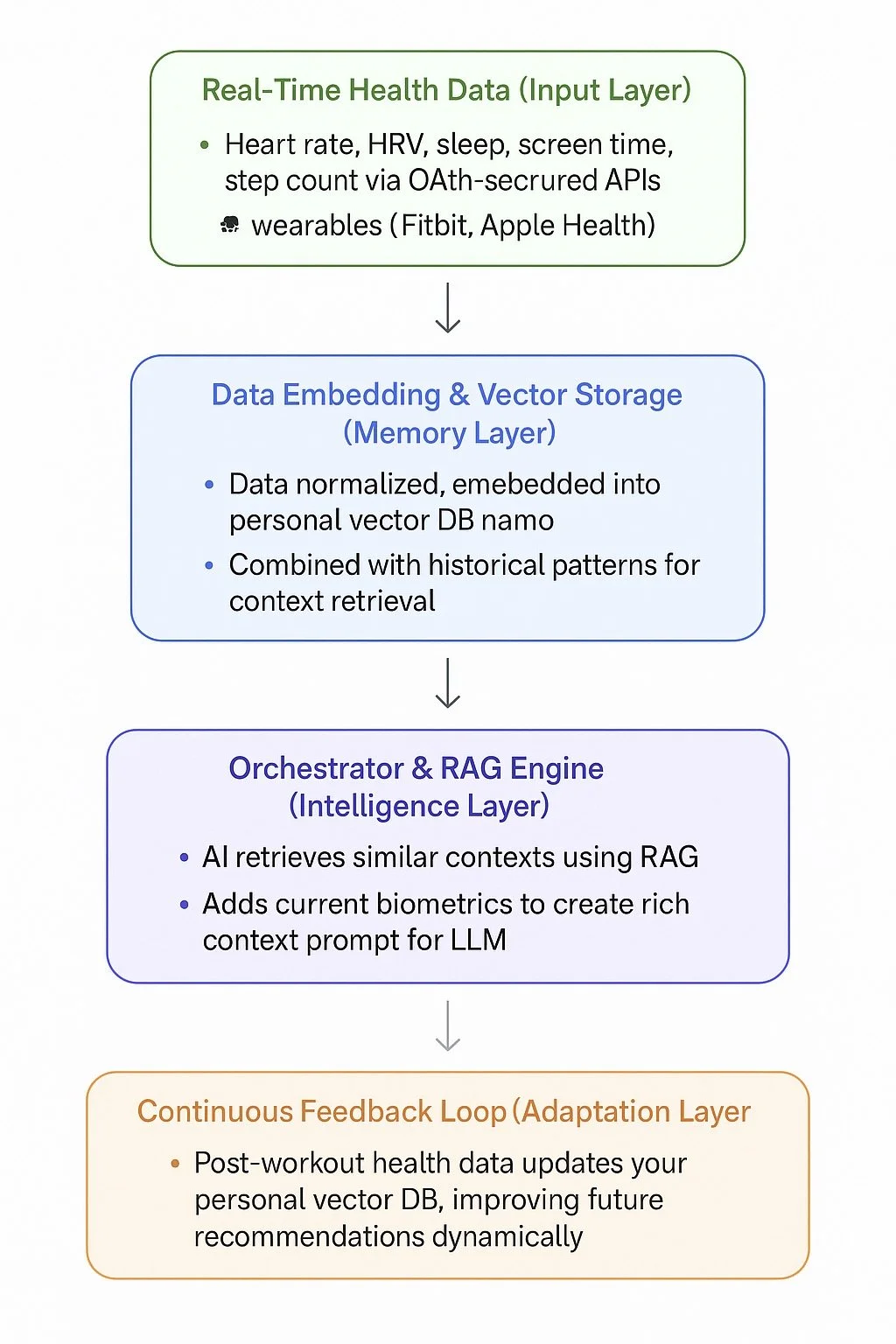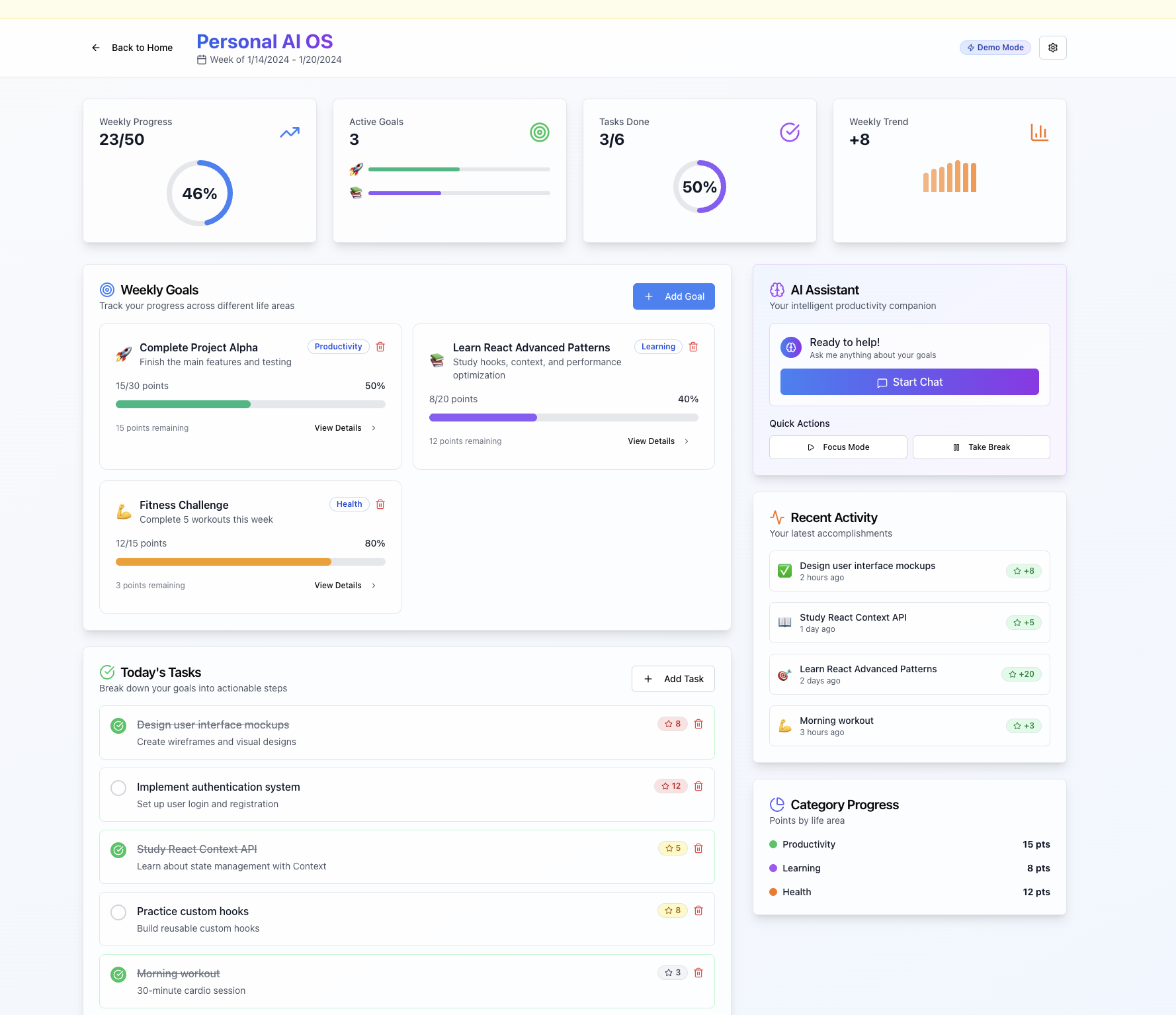Personal AI OS
One intelligent hub to manage and gamify my daily life. AI-powered apps and assistants that know my world—powered by OAuth, MAP, graphRAG, and private vector databases.
-
The static, disconnected app model no longer serves modern life. People juggle fragmented tools that provide functionality but lack intelligence, while current AI assistants remain shallow and context-blind.
My personal AI OS addresses this gap. It is not another app, but an operating system for orchestrated intelligence—a modular, adaptive framework that unifies data and decisions across every area of life.
At its center is the AI Orchestrator, which harmonizes specialized agents (finance, health, productivity, social, creative) and dynamically balances priorities based on logic, signals, and personal goals.
Continuously learning from feedback loops—physiological data, spending habits, communication tone, and global events—the system evolves in real time. Instead of offering insights alone, it translates data into coordinated, actionable decisions, aligning daily choices with long-term aspirations.
-
Today’s digital world is dominated by isolated apps—banking, fitness, calendars, task managers—that demand attention but lack awareness of the bigger picture. This fragmentation forces users into constant micro-management, as no system integrates data across life’s domains.
AI assistants were meant to solve this but remain shallow, offering generic responses without situational awareness. They cannot sense urgency, adapt to personal states, or provide continuity across interactions. Instead of reducing complexity, they add to the noise.
The core issue is the lack of contextual intelligence—memory, adaptability, and integration of diverse signals like health data, communication patterns, and shifting priorities. Without this, individuals are left to act as their own system integrators, draining time and cognitive capacity in an increasingly complex world.
-
Technology has long existed as fragmented tools, effective individually but disconnected from the bigger picture of our lives. Personal AI OS introduces the next evolution: an intelligence layer that unifies these fragments into a coherent, adaptive system.
At its foundation, it builds an ecosystem of specialized AI agents (finance, health, productivity, social, etc.) that collaborate like musicians in an orchestra. A Master Orchestrator acts as the conductor, integrating insights across agents and aligning them with personal goals. This orchestration is context-aware and dynamic, driven by data and feedback loops.
The system connects securely to real-world data sources—calendars, banking, wearables, cloud services—using OAuth, and organizes this information into modular vector databases. This design preserves privacy while enabling memory, continuity, and scalability.
With weighted reasoning, the Master Orchestrator balances competing priorities and generates actionable, interdependent guidance. For example, it might recommend stress-reducing exercises, alert about financial market shifts, and prepare work follow-ups—all harmonized to immediate needs and long-term goals.
-
Input Layer
• OAuth-secured API connectors for email, calendar, financial accounts (including trading, banking), social accounts, and wearable/health sensors.
• Data ingestion via Kafka or AWS Kinesis for real-time streams.
• Event streams separated into events.raw (for MAP) and facts.raw (for Graph).
Context Layer
• Vector databases (Pinecone or Milvus) per domain for embeddings.
• Contextual caching with Redis for fast retrieval and short-term MAP memory.
• MAP Store for mid- and long-term episodic memory (summaries, preferences, timelines).
• Graph Database (Neo4j/TypeDB) for structured entities and relationships between people, tasks, projects, and goals.
Orchestration Layer
• Microservices running on Kubernetes, using gRPC for inter-service communication.
• Weighted orchestration logic engine for decision-making.
• Context Router (NEW): hybrid retrieval across Vector DB, Graph DB, and MAP memory.
• MAP Updater Service: rolls up episodic events into summaries, updates long-term memory, and pushes stable facts into Graph and Vector DBs.
Generative Reasoning Layer
• Multi-model orchestration using OpenAI GPT-5 + local fine-tuned models for privacy.
• Graph query tools (Cypher/Gremlin) for subgraph reasoning.
• MAP retrieval tools for episodic and time-aware memory.
• Responses built from blended context: semantic (Vector), relational (Graph), and temporal (MAP).
Output Layer
• Web dashboard built in Next.js with GraphQL API.
• Real-time UI updates via WebSockets.
• Graph visualizations (entity relationships, dependencies) and MAP timelines (streaks, goal progress, episodic memory playback).
Scalability
• Event-driven architecture for scalability (Kafka/NATS).
• Horizontal scaling for domain-specific agents via Kubernetes.
• Read replicas for Graph queries; Redis caching of subgraphs and hot memories.
Why Personal AI?
I had to stop paying for and juggling dozens of generic apps. My AI OS integrates health stats, calendar, messages, stock market positions, personal finance, facebook posts history and more into one orchestrated experience that knows me. Secure OAuth ensures my data powers personalized advisory insights better than anything I could find on the app store.
Unified AI Dashboard
I manage 20+ uses cases through apps and assistants with a single login. Calendar, Finance, Social Posts, Gym Routine, Stock Trading, Social Reminders, Upcoming Risks are all in one interface.
OAuth-Powered Privacy
My data never leaves my control. OAuth + local vector DB = trust.
Master Orchestrator
A single chat interface routes queries to multiple AI apps behind the scenes.
Better Than Generic Apps
No more templated apps built for millions of people. I wanted personal advisory as my AI OS adapts to my data and life, not the other way around.
How It Works
Each AI assistant uses Memory Augmentation Process (MAP) graph Retrieval-Augmented Generation (RAG) with its own vector DB. A Master Orchestrator coordinates responses and context. OAuth secures my integrations.
Current Progress
Functional dashaboard and chat interface developed. I'll be testing new users once I've got this to a place of full enjoyment. Open to emails, video calls, and coffee meetings in Columbus, Ohio

